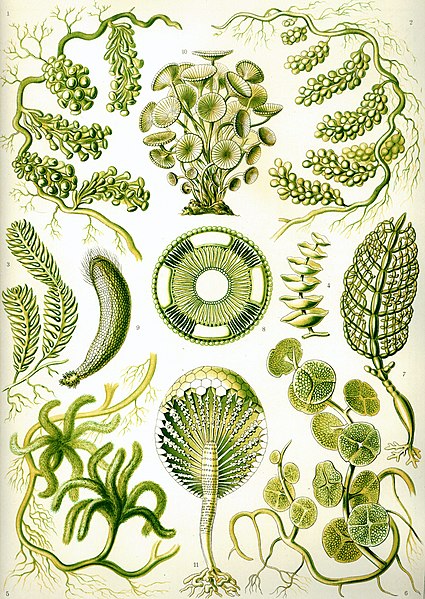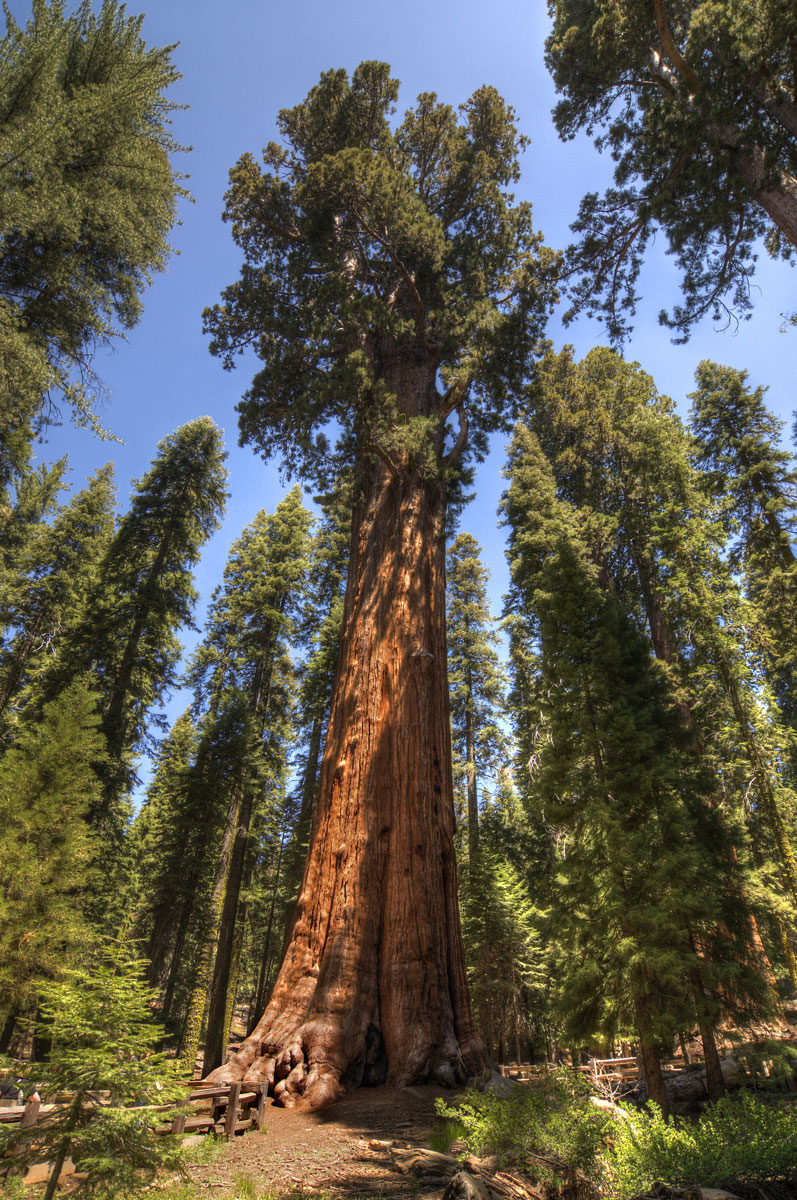I saw this Nature program on TV about all that is strange and wonderful about Australia. At one point they mentioned the huge mountain ash 'Ada' that was the tallest tree in the world until lightning took its top off. Even still, I think it is the largest flowering plant on Earth. That got me wondering about the evolution of trees. How do you go from marine plant life, depending on water for support, to huge trees on land reaching over 100 meters in height, supported by a trunk? I'm going to attempt a very brief, very simple, very unplanned accounting of this. And keep in mind, I'm no botanist!
A tree is a vascular plant in that it is capable of transporting water internally, but under water such a transport system in unnecessary; there, every cell has access to and can absorb nutrients directly from the surrounding environment. Land plants are thought to have evolved from nonvascular green algae, maybe a division called Chlorophyta.
So, how do you go from green algae to vascular plants? This is where a bit of speculation takes place, but it is always that way when talking about periods so long ago. Still, green algae must have been swept up on the shore or trapped in evaporating ponds and pools, as happens even now. Over millions of years some algae developed a tolerance to dryness and to the more extreme temperature swings on land. But, there is a definite limit to how tall and how large a plant can get in the absence of a rigid cell wall or without the means to transport and store water.
It is estimated that the origins and early evolution of land-plants began between 480 and 360 million years ago, in the mid-paleozoic era. It seems that the components needed for the development of a rigid cell wall - polysaccharides such as cellulose and hemicelluose, and the fiber lignin - were present in algae before that transition to land:
the story of cell wall evolution after the colonization of land appears to be characterized mostly by the elaboration of a preexisting set of polysaccharides rather than substantial innovation. (link)
Their cell walls are thin and can easily absorb water, but are not capable of offering structural integrity or the means of transporting water internally. Mosses are the hardiest and most "advanced" of the byrophytes and can be found in very dry locations. In order to accomplish this they evolved thicker cell walls, able to more effectively store water, and also sporangia to aid in reproduction - before that algae and simple byrophytes required water to transport their spores.
Moss sporangia have specialized cells that cause a sudden rupture of the sporangia and high-speed liberation of spores. Some higher mosses display thick-walled cells that are connected to each other, which could be viewed as the precursors of vascular tissues. (link)
Another interesting idea is that lichens were the predecessor of vascular plants. Lichens are a symbiotic relationship of fungi and green algae, and would have coloured the rocks during this era. There are some features within vascular plants that resemble fungal elements such as hyphae, leading some researchers to wonder if this indicates an ancestral connection.
This reminds me of how it is now generally accepted that our very own mitochondria were once actually bacteria according to the endosymbiotic theory. Mitochondria have separate DNA in the form of a loop, much like the plasmid of many kinds of bacteria.
Anyway, whether from mosses or lichens, vascular plants eventually came on the scene.
The vascular system of a plant consists of two types of transport tissue: xylem and ploem.
Fossils have been found in Scotland of a plant called Cooksonia, the oldest known plants to have a stem with primitive vascular tissue. They would have existed around 400 million years ago, and belong to the genus Rhynia:
These plants crowded around moist areas, and so began the endless competition for light; those plants that could grow taller than the surrounding vegetation would have the best chances for survival.
Fun fact: the first true vascular leaves to evolve probably occurred within the division of lycopods;
The limits to the height a plant could grow were overcome by the development of secondary growth. Before then growth of the stem would occur vertically only, without any increase in the diameter of the stem.
From here I think we can imagine roughly how things would have gone: bigger, tougher, taller











Plants are really very weird, when I think about it. Life without consciousness. Closer in that respect to bacteria. Though interesting that the vascular sytems in plants (mimicking in a way the artery/vein system of animals albeit without any 'centre') evolved independently.
ReplyDelete...Though maybe not that interesting really. Lots of things evolve independently if needs must. Otherwise one might get to thinking whales were fish.
Convergent evolution is the coolest thing. Wings also evolved independently in a few different lineages. And whales...that shit is just too cool. When I found out that the closest living relative of whales was the hippo...mind. blown.
ReplyDeleteOh hippos are just the trippiest cousin to have.
ReplyDeleteAnd most violent too.
The fact that birds are literally dinosaurs and that a bunch of them pace around the lawn outside my window every day is also a bit of a mindblower. I look out at those magpies, blow smoke and think 'we won, you fuckers. We won.'